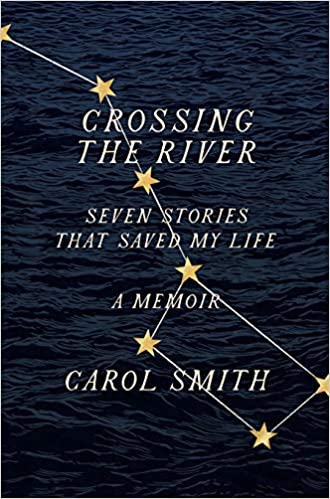Reviewed by Lisa Ellison
 As a kid I loved stargazing. Head back, I’d identify the constellations and their stories or imagine myself as a sea captain steering a ship by starlight. After my brother’s 1997 suicide, I again looked skyward, this time begging the stars to help me navigate this unbearable loss.
As a kid I loved stargazing. Head back, I’d identify the constellations and their stories or imagine myself as a sea captain steering a ship by starlight. After my brother’s 1997 suicide, I again looked skyward, this time begging the stars to help me navigate this unbearable loss.
Over the past 24 years, I’ve read a couple dozen grief memoirs. Each one taught me something essential about loss. Then I encountered Crossing the River: Seven Stories that Saved My Life (Harry N. Abrams Press, May 2021) by Carol Smith. In its opening pages, Smith ferries herself across Lake Washington. On one side is the home where she keeps her dead son Christopher’s belongings. On the other is her job as reporter for the Seattle Post-Intelligencer. It’s a place where few people know she was once a mother. Telling her subject’s stories helps her cope with the enormity of her loss and the constant triggers she encounters.
The book is structured like a constellation. Each article Smith reports for the Post-Intelligencer serves as a star. Together, they reveal a collective image of grief and resilience. The stories oscillate between ordinary people who’ve faced extraordinary struggles, like ten-year-old Seth who’s been diagnosed with progeria (a rare syndrome that causes children to age prematurely), and extraordinary people facing everyday losses, like decorated war hero and stroke victim General John Shalikashvili. Within each vivid, powerful, and complete arc Smith humanizes her character’s suffering while shining light on their strengths and the ways each struggle mirrors her own.
The heart-shattering grief Smith expertly weaves throughout the book reads like poetry. She uses fresh, precise descriptions like “the sun locked behind a scrim of gray” to set a scene’s tone. When a nurse announces Christopher’s death to his classmates, “the trace scents of crayons and Band-Aids, mud and baseball leather, kept [her] breathing.”
Whenever I select a grief memoir, I wonder whether I’ll be overwhelmed by narrator’s soul-crushing pain. Even though Smith writes about challenging subjects, I couldn’t put her book down. When I had to, her stories stuck with me. I cared about her characters and their challenges. The book’s success hinges on its structure and the way Smith tethers her stories to one resilient thread. The wisdom Smith renders from these experiences reads like a gripping “how to” on coping with loss. Through a combination of her scene-driven narratives and Smith’s poignant reflections we discover where children place their focus, the power of scars, and the importance of discipline, risk, and gratitude. Her characters show us how to integrate grief into our lives and why we need to choose hope and celebrate even when there’s sadness.
While I fell in love with every character in Crossing the River, the brightest star was Christopher—Smith’s bright, happy, funny boy who was born incompatible with life. A blockage in Christopher’s urinary tract while he was in utero led to significant post-birth complications, including kidney damage and a profound hearing impairment. His life was always precarious, yet he fully lived. He loved school and his friends; he delighted in small toys and the pleasure of turning seven and growing strong enough to play ball like the rest of the boys his age.
Smith brings Christopher to life through his primary language, American Sign Language (ASL). She intersperses descriptions of ASL signs throughout Christopher’s scenes. Through them we experience his unique point of view. For example, when Smith and Christopher encounter their lengthening shadows, she must make up a word, so she signs sun and picture. “Sun picture. That’s how he looked at the world. Where others saw darkness, he saw light.”
Because I speak rudimentary ASL, I could easily picture Smith’s gestures. While I believe she describes them effectively, readers unfamiliar with ASL might have a different experience. But any struggle is worth the effort. The physicality of this speech adds another layer of poetry to her writing. I’ve yet to read a memoir that honors the deaf experience so elegantly.
Another strength of this book is the way Smith withholds the answer to the book’s essential questions. What precisely caused Christopher’s death? How does this knowledge affect Smith’s ability to heal? Just when I think the big reveal has arrived, the book moves on. In the end, its the culmination of her stories that prepares us to fully appreciate the answer’s payoff. The move felt like an homage to Joan Didion’s The Year of Magical Thinking, but with the tension of Lacy M. Johnson’s The Other Side.
She nails the ending, and the wish I’d once had. Her memoir reads like a mariner’s star map—each story guides Smith back to herself, and as result shows us all how to live after unimaginable loss.
EDITOR’S NOTE: You can hear Carol Smith read from her memoir as part of the Debut Author’s Panel at HippoCamp: A Conference for Creative Nonfiction Writers from August 13-15 in Lancaster, PA. For more information about the conference and to register, please visit the HippoCamp website.
 Lisa Ellison is an editor, writing coach, and speaker with an Ed.S in clinical mental health counseling and a background in mindfulness. She has spent the last two decades helping clients and students turn difficult experiences into art. Her life story and essays have appeared on NPR’s With Good Reason and in Hippocampus Literary Magazine, Kenyon Review Online, and The Guardian, among others.
Lisa Ellison is an editor, writing coach, and speaker with an Ed.S in clinical mental health counseling and a background in mindfulness. She has spent the last two decades helping clients and students turn difficult experiences into art. Her life story and essays have appeared on NPR’s With Good Reason and in Hippocampus Literary Magazine, Kenyon Review Online, and The Guardian, among others.


